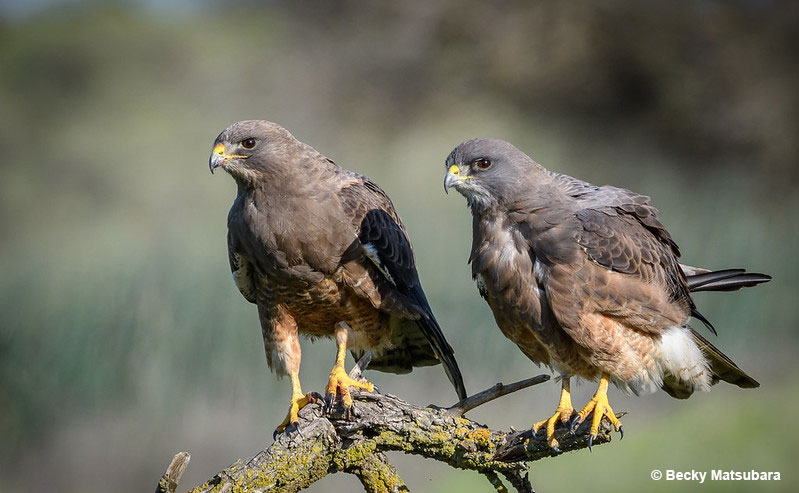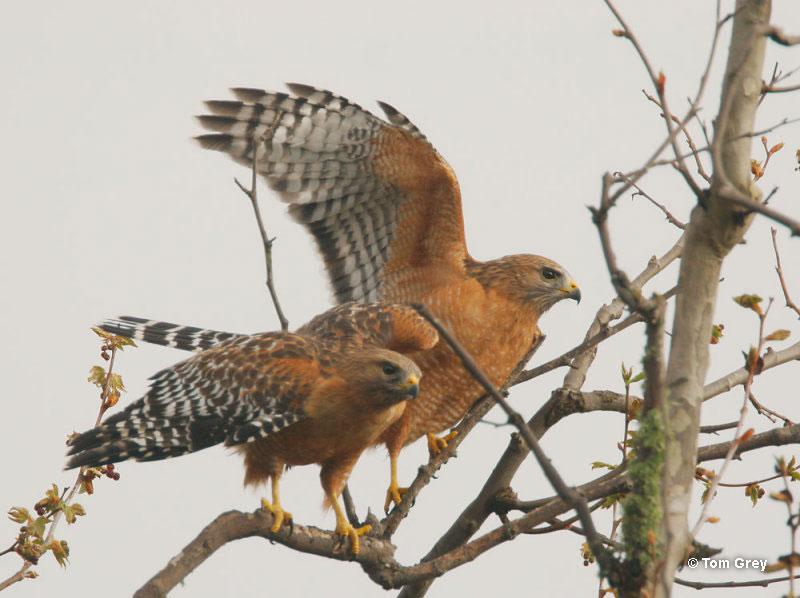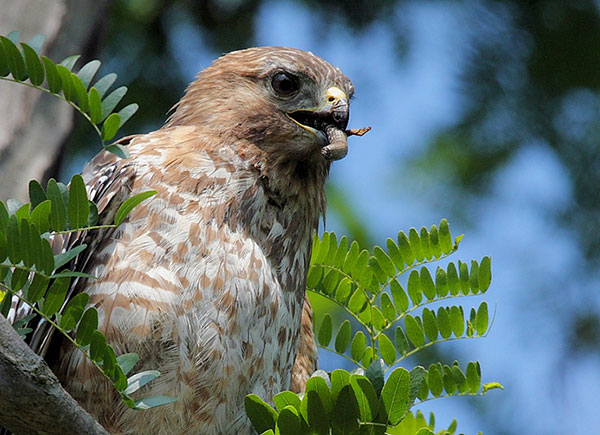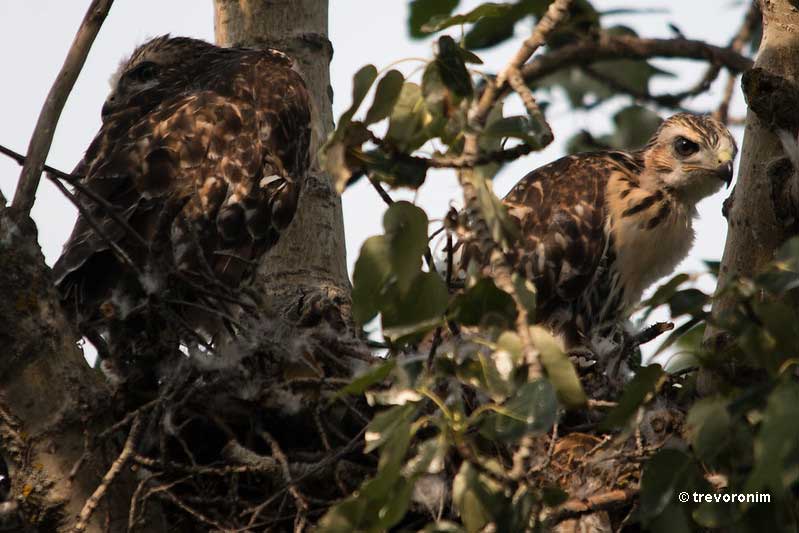
The female hawk is not too different from its male equivalent, so telling the difference can be challenging.
Hawks are known as predators of the skies, glorified for exceptional strength, keen eyesight, and impressive flying abilities.
In most hawk species, the females are larger and stronger than the males – sometimes significantly. This size disparity is the main sex difference in hawks and a fascinating characteristic that sets them apart from many other birds.
Female vs Male Hawks
Most female and male hawks have similar or identical physical traits – except for their size and weight. The difference in size is a universal trait distinguishing male and female hawks across species.
This difference is not easy to tell without comparing the two birds (unless you’re used to seeing hawks and can notice if the individual of a certain species is smaller or larger at a glance).
Some hawks do show a sex difference in plumage color. However, this is only the case with certain Accipiter species.

Red-shouldered Hawks. The female appears to be behind the male.
Plumage
Female hawks and male hawks often have nearly identical plumage.
Some hawk species exhibit classic sexual dimorphism, where the male is more colorful than the female, but for hawks, this is not too common.
Size Differences
In most hawk species, females are larger and more robust than males. This size disparity is known as reverse sexual dimorphism.
Here are some examples.
- Female Northern Goshawks are notably larger and bulkier than their male counterparts, often weighing up to 50% more.
- Female Cooper’s Hawks can be up to 40% heavier than their male counterparts.
- In Red-tailed Hawks, females are 25% larger than males.
Why are female hawks larger than males?
While this size disparity is common among raptors, the reasons behind it are still not fully understood. Several hypotheses exist, but biologists still have no consensus on the definitive explanation. In fact, there were around two dozen hypotheses on raptor sexual dimorphism over the last 50 years!
One hypothesis suggests that different-sized males and females avoid competing for the same food sources.
The females hunt larger prey (like rabbits or squirrels), while the males can focus on smaller prey animals (such as mice). This specialization in prey selection could reduce competition within the pair and maximize the efficiency of their hunting efforts. However, this theory needs to fully account for why the female is larger and not the male – were the situation reversed, there would be no competition either.

Another proposal suggests that larger females have an advantage in outcompeting other females for territories and mates and in defending their nests against predators. However, both males and females defend the territory and compete with other pairs.
Perhaps the most convincing argument is related to the female’s role in defending the nest and young against predators.
In hawks, both parents care for the young; still, the females spend more time incubating the egg and around the nest.
The females’ larger size may enhance their ability to protect the offspring and themselves at the nest. Meanwhile, the male’s smaller size and the agility that comes with it allow him to hunt smaller prey efficiently and thus provide for the female and their offspring.
Behavior
Behavioral discrepancies in female and male hawks seem to be dictated by their anatomical differences. These distinctions are complementary and enhance the hawk pair’s ability to hunt and provide for their young.
In some species, females have broader wings, allowing for efficient soaring and long-distance flights. For example, in Red-tailed Hawks, females possess broader wingspans that aid in their extensive foraging excursions. Thus, female hawks are more enduring hunters who often tackle large and challenging prey.
Related: Hawks in the United States – identification challenges
Conversely, males tend to have narrower wings, which boosts their agility and maneuvering abilities during courtship displays and hunting but decreases their endurance. Therefore, males are better adapted for hunting smaller, quicker prey and in tricky spots such as thickets where maneuvering abilities matter.
How to tell a younger hawk’s gender?
Telling the sex of immature hawks can be tricky. Plumage variations in this age are unnoticeable even in species such as kestrels, where color sexual dimorphism exists in adults.
However, even young females will be heavier and bulkier than the males of the same generation. The difference might be hard to notice if you are looking at individual birds rather than comparing them in groups.

Hawk Lifecycle
The life of each hawk begins in the sturdy nest built and maintained by parent hawks. Upon hatching, all hawk chicks are altricial, meaning they are helpless and completely dependent on their parents. Luckily, the parent hawks tirelessly provide food and protection for their vulnerable offspring during their early life.
Over time, the juvenile hawk gains strength and agility. The first downy feathers are gradually replaced by juvenile plumage.
Despite still being fed exclusively by parents, baby hawks practice prey manipulation and independent feeding. At the same time, they train flying by stretching and flapping their wings at the edge of the nest or the nesting site.
Occasionally, hawk chicks will engage in siblicide – an occurrence when the older, stronger chick kills its weaker sibling. Although science has yet to pinpoint the exact reasons for siblicide (which, by the way, occurs in many bird species), there is evidence that the lack of food can trigger the phenomenon. Still, the notion that siblicide happens regularly in birds of prey is a myth.
Once the juveniles fledge 40-something days after hatching, they become increasingly independent. Remaining in the nest’s proximity, they continue practicing flight skills and hunting, still under the watchful guidance of the parent hawks.

Young Northern Goshawk
Gradually, the young hawks become proficient in hunting and navigating the environment. They gain adult plumage in the second year of their life. Once fully mature, the young hawks venture independently. Each will establish a new territory and try to find a mate to continue the life cycle, completing the circle by nesting and raising its own brood of chicks. The new pair will return to the same site year after year, as their parents have done on their territory.
The average lifespan of a small hawks is around 15 years. Larger members of the Accipitridae family, like the medium-sized buzzards and kites, can live longer – up to 20 to 40 years.
Frequently Asked Questions
What is a female hawk called?
An archaic word for a female hawk is “formel”. The term is rarely used today.
Bird scientists don’t have specific terms for female (or male) hawks. Male hawks are sometimes called “tiercels”, but there is no such term for female hawks. Sometimes, the general term “hen” or “hen-bird” is applied.
What’s the difference between a male and female hawk?
The main difference is the body size, especially regarding weight. In some species, a female can be 50% heavier than the male. This trait is unusual in the avian world, where males are usually the same size or larger than females. Thus, the phenomenon is known as reverse sexual dimorphism.
Some rare species of hawks, such as kestrels, also display “typical” dimorphism, where males are more colorful than females.
Do hawks mate for life?
Hawks tend to mate for life unless their partner dies or they fail to find each other at the beginning of the mating season. Then, each may seek another partner.
However, the hawk partnership is not as romantic as it may sound. Although the pair can be affectionate toward each other, they are solitary for the most part and get together only for nesting. Even then, the birds will spend most of the day hunting separately.
Experts believe that pairing for life occurs primarily out of hunting and nesting habits – the birds tend to return to the same territory for both.
Conclusions
Hawks are magnificent birds of prey that captivate us with their aerial skills and keen hunting abilities. Another interesting and often overlooked aspect of hawk biology is their sexual dimorphism – the physical differences between males and females.
In most hawk species, females are larger and more robust than males, which is unusual in the bird world.
Although the science is not clear why exactly the size disparity has occurred, trying to understand the sexual dimorphism in hawks nevertheless provides important insight into their evolutionary adaptations. They are surely a consequence of natural selection and the pressures of their environments.
Whether talking about the larger, robust females or the smaller, agile males, each sex has evolved traits that optimize survival and reproductive success. Their respective skill sets fit like pieces of a puzzle, all to form a pair that will successfully continue the species’ natural legacy.
